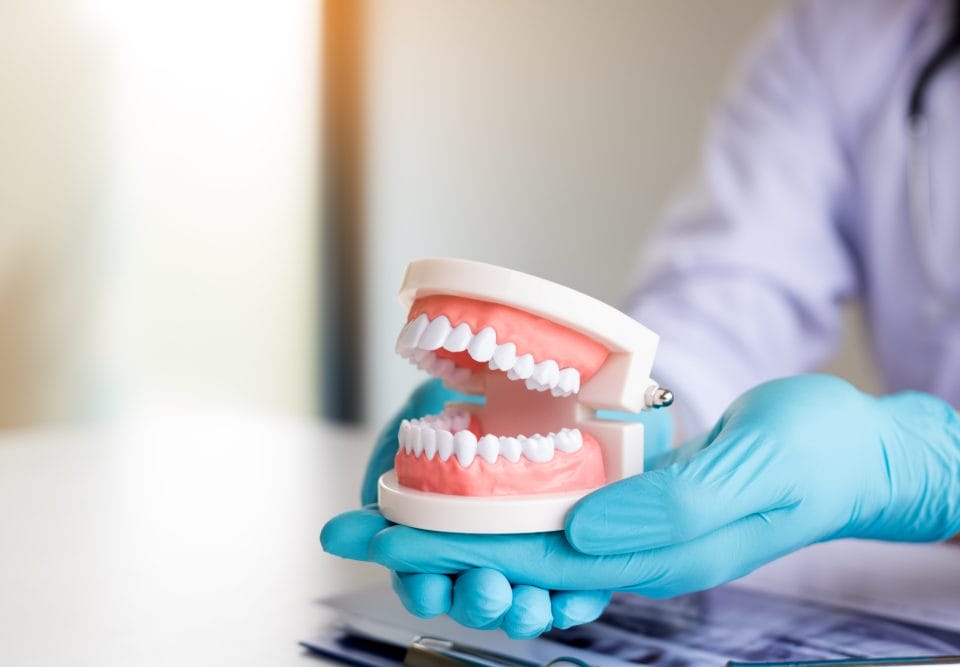
Having a dental emergency? Call us!
614-882-1135
We understand that dental emergencies can happen at any time. If you're in need of urgent care, give us a call, and we'll do everything we can to assist you when it matters most.
Patient Testimonials
Discover Better Dentistry
Become a part of the
Westerville Dental family!
We're accepting new patients. Our dental team prides itself on delivering a truly efficient and enjoyable experience while you’re with us.

A bright and confident smile is a reflection of a happy and healthy life. However, dental issues can arise at any moment, leaving us feeling self-conscious and insecure. One such issue is missing teeth. Dental bridges are one way to restore your smile with natural-looking teeth that are custom-fit to your mouth, preventing the shifting or becoming crooked of neighboring teeth.
Different Types of Dental Bridges
Dental bridges come in three primary types: traditional, cantilever, and Maryland bridges, each with distinct characteristics. Selecting the appropriate bridge type depends on numerous factors such as the gap’s location, condition of adjacent teeth, and individual preferences. Traditional bridges, which are a type of dental bridge, are anchored by placing a crown on either side of the missing tooth or implant to hold the pontic in place. Cantilever bridges are an excellent option when there is only one adjacent tooth available for anchoring. Maryland bridges, also known as resin-bonded bridges, are attached to adjacent teeth using a metal or porcelain framework.
It is important to note that the success of any dental bridge depends on various factors such as proper oral hygiene practices and regular dental checkups. Regular brushing and flossing, along with good dental care, can help prevent decay and gum disease, which can cause damage to the abutment teeth and weaken the bridge’s foundation. Additionally, routine dental visits can help detect any potential issues early on and ensure that your bridge remains stable and secure for years to come.
Traditional Dental Bridge
Traditional dental bridges involve the creation of dental crowns for the teeth or implants on both sides of the gap, providing a strong and natural-looking solution for replacing missing teeth. These fixed bridges are cemented in place, offering stability and support for the artificial tooth between the healthy teeth or abutment teeth. Customized by dental laboratory technicians, the bridge ensures a precise fit and seamless integration with natural teeth. Patients with traditional bridges must maintain good oral hygiene, including regular brushing, flossing, and dental check-ups, to ensure longevity and oral health.
Cantilever Dental Bridge
When adjacent teeth are present only on one side of the gap, a cantilever dental bridge is a suitable option. It offers a reliable and functional solution for restoring the smile’s functionality and appearance. The biting forces and the condition of the remaining natural teeth must be carefully considered. These bridges are securely bonded to the adjacent single tooth, providing stability and support for the false tooth. Patients with cantilever bridges should follow proper care guidelines to ensure the longevity of the restoration.
Maryland Dental Bridge
A Maryland bridge, which is also called a resin-bonded bridge. This kind of bridge uses a metal or porcelain frame with metal wings that’s attached to the back of the teeth next to the gap, and it holds a fake tooth in place. Maryland bridges work well for front teeth, and they look natural and last a long time. Plus, they’re a good choice if you want to keep your other teeth healthy and clean.
The Procedure for Getting a Dental Bridge
The non-invasive dental bridge procedure is a two-visit process that involves preparation and placement. During the first visit, the dentist prepares the abutment teeth, takes impressions, and fits a temporary bridge while the permanent one is crafted. The second visit is for placing the bridge and ensuring proper fit and bite alignment. After the procedure, good oral hygiene and proper care are essential for maintaining oral health and preventing tooth loss. It is crucial to follow up with regular dental check-ups to ensure the longevity of the dental bridge. With proper care, a dental bridge can provide long-lasting results and improve overall oral health.
Caring for Your Dental Bridge
If you have a dental bridge, maintaining optimal oral hygiene is essential to ensure its longevity and your overall oral health. This involves preventing gum disease, tooth decay, and the loss of adjacent teeth. Regular dental check-ups and care are necessary to keep the bridge in good condition.
It is also important to take proper care of the different components of the bridge, such as the dental cement, metal framework, false teeth, and artificial teeth. Avoiding sticky or hard foods can aid in preserving both the bridge and remaining teeth. Understanding your insurance coverage for bridge care, dental crown replacement, false teeth, or dental laboratory fees can also help ensure that your bridge remains in excellent condition.
To maintain good oral hygiene with a dental bridge, it is crucial to brush twice daily using fluoride toothpaste and floss regularly to remove plaque buildup around the bridge. Rinsing with an antiseptic mouthwash can also help reduce harmful bacteria in your mouth.
If you experience any issues with your dental bridge such as discomfort or looseness, schedule an appointment immediately. Timely treatment can prevent further damage and prolong the life of your dental bridge.
Are Dental Bridges the Right Choice for You?
Considering dental bridges? Find out if they’re right for you! Factors like oral hygiene, adjacent teeth health, insurance coverage, and bridge type influence the decision. Discuss options with Westerville Dental Associates to make an informed choice. Dental bridges offer a natural-looking solution, enhancing oral health and smile appearance. Assess benefits, procedure, cost, and impact on oral health to determine suitability.


 Meet Dr. Zody
Meet Dr. Zody Meet Dr. Choi
Meet Dr. Choi Meet Dr. Son
Meet Dr. Son









